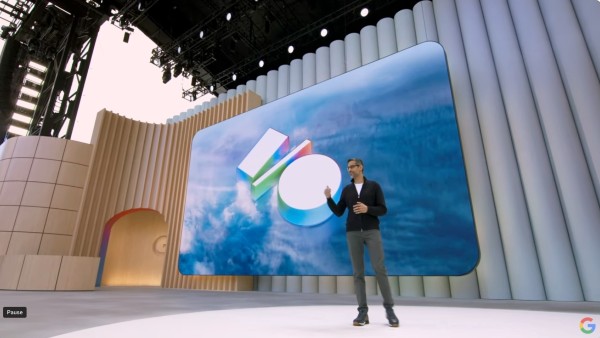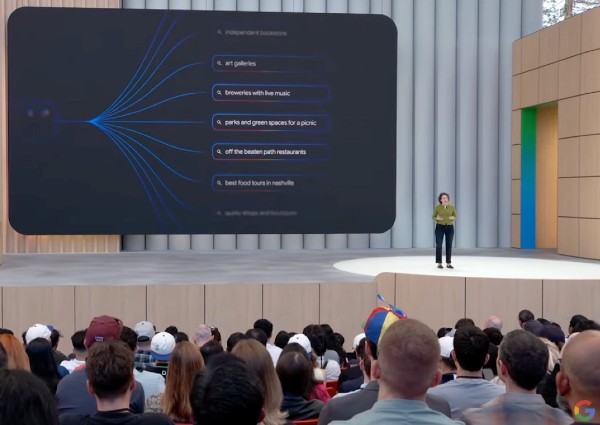Google I/O 2025 was rich with AI focused announcements. For B2B marketers, the implications of the AI advancements in terms of search engine experience represent a new level of transformation. The TLDR is search has gone from information to intelligence and is evolving into a multimodal, agentic assistant that understands user context, performs reasoning, and retrieves the most relevant, timely, and personalized results-across languages, formats, and intent types.
The updates at Google I/O related to search were not your typical incremental updates, but a fundamental reshaping of how customers will discover, consume and interact with information through search. As a result, I think it’s safe to say that the old SEO playbook of simply chasing rankings is being replaced.

Sundar Pichai, CEO at Google & Alphabet
The more we dig in to these announcements, see reactions from the industry and observe changes through the work we do for B2B clients, the clearer it becomes that the future of the B2B search experience is diversified beyond Google. And the same time Google continues to represent opportunity for those that can adapt and especially for those who can become the best answer across the entire buyer journey.
Decoding Google I/O for B2B Marketing SEO in 2025
Google’s newest improvements signal a fundamental change in how users will discover and consume information online. I really like how Britney Muller summed up this shift in the relationship between user, Google and website content:

With such transformational change from organization to interpretation, it’s important to understand what these changes are, what they mean for B2B marketers and what you can do to optimize for the new reality of AI powered search. Here’s a breakdown plus tactical tips from both Google and Microsoft as it relates to optimizing for AI-powered search:
1. AI Mode in Search: Synthesized Answers Replace Link-First Results
What’s Changing: Google’s new AI Mode delivers conversational summaries directly in the search results, pulling insights from multiple sources and presenting them inline, reducing the traditional 10 blue links even further.

Liz Reid, VP, Search at Google
The Power of Query Fan-Out: As Google shared when they introduced AI Mode, user searches can result in the use of a “query fan-out technique, issuing multiple related searches concurrently across subtopics and multiple data sources and then brings those results together to provide an easy-to-understand response.” The user can also easily as follow-up questions and exploring related aspects of their initial query in a conversational manner. This evolution reinforces the need for B2B content marketing and SEO efforts to go beyond individual keywords or topics and towards addressing a comprehensive range of related ideas. Think, topic clusters on steroids.
Impact for B2B Marketers: Content may no longer drive traffic simply by ranking. Inclusion in AI summaries now depends on perceived helpfulness, clarity, and credibility. Without the right structure and authority signals, your brand could be left out.
Recommendations:
- Demonstrate E-E-A-T (Experience, Expertise, Authoritativeness, Trust): Ensure your content features named authors, expert quotes, and external citations. (Source: Google Search Central Blog)
- Prioritize unique, high-value insights (“information gain”): Provide original data, perspectives, or frameworks that add value beyond standard content. (Source: Microsoft Ads Blog)
- Use clear headings and structured formats: Help AI systems parse and repurpose content more effectively. (Source: Google Search Central Blog)
2. Deep Search: Multi-Layered Research Results from One Query
What’s Changing: With Deep Search, Google dissects complex queries into multiple sub-questions, conducts parallel searches, and presents an integrated, layered set of results.
Impact for B2B Marketers: Long-form, in-depth research by B2B buyers will now be met with synthesized multi-dimensional answers. This creates new visibility opportunities if your content ecosystem supports a wide breadth of connected topics.
Recommendations:
- Create topic clusters and interlinked content ecosystems: Organize related content under central themes (e.g., pillar pages with support articles). (Source: Google Search Central Blog
- Map content to buyer stages: Build content that addresses awareness, consideration, and decision-level needs. (Source: Microsoft Ads Blog)
- Use structured navigation and internal links: Help Google understand how your content connects across themes. (Source: Google Search Central Blog)
3. Hyper-Personalized Results: Every Buyer Sees a Different SERP
What’s Changing: Search results are already pretty unique per person, but now Google is amplifying that personalization by using contextual signals from Gmail, YouTube, Maps, and prior search activity to shape unique search result sets for each user.
Impact for B2B Marketers: The same keyword can trigger different results for different users, based on their behavior. That means traditional rankings are no longer static. B2B Marketers will need to build relevance signals across multiple touchpoints and content types – which aligns with our Best Answer Marketing strategy, perfectly.
Recommendations:
- Segment content by audience, industry, and buying stage: Build specialized assets tailored to buyer context. (Source: Microsoft Ads Blog
- Establish presence across Google surfaces (YouTube, News, Business Profile): Boost your brand’s relevance across channels that feed into personalization. (Source: Google Blog)
- Blend organic and paid strategies: Coordinate content and ad campaigns to maintain presence across the personalized spectrum. (Source: Microsoft Ads Blog)
4. AI Agents: Search That Takes Action on the User’s Behalf
What’s Changing: With Project Astra and Project Mariner, Google is evolving Search into a task-completing platform. These agents help users summarize research, make comparisons, and even complete transactions-within the search experience.
Impact for B2B Marketers: If your content isn’t formatted to support actions like comparing solutions or initiating a demo, it may be skipped over. AI agents are creating a new layer of “zero-click conversion paths” that brands must optimize for. There is growing evidence of B2B buyers using GenAI and agents to assist in sourcing solutions, so features like Project Mariner from Google which, as a simple Chrome extension, is pretty compelling and will add to those resources.
Recommendations:
- Use structured data (e.g., schema.org markup): Tag your content to make it machine-readable and usable in AI outputs. (Source: Google Search Central Blog)
- Enable interactive content experiences (calculators, ROI tools, comparison tables): Make it easy for AI agents-and users-to act without friction. (Source: Microsoft Ads Blog)
- Ensure clear CTAs and next steps are embedded in content: Position your content to support not just reading-but doing. (Source: Google Blog)
5. Ads in AI Overviews: Paid Search Becomes Embedded Context
What’s Changing: Google is testing sponsored placements directly within AI-generated summaries. These ads appear natively inside AI answers instead of alongside or above them which changes the expectations for ad format and tone.There are issues to be resolved as it relates to tracking referred ad traffic and distinguishing whether the ads were normal Google ads or AI Mode ads.
Impact for B2B Marketers: Paid placements must now add value and align contextually with the AI response. This calls for updated messaging strategies, closer coordination between paid and organic efforts, and deeper alignment with the buyer journey.
Recommendations:
- Use “Search Themes” and Performance Max to guide ad relevance: Help Google understand what your business does and when your ads are relevant. (Source: Google Blog)
- Match ad copy tone to educational and conversational AI outputs: Focus on helpful messaging rather than promotional jargon. (Source: Microsoft Ads Blog)
- Coordinate paid and organic content strategy: Ensure campaigns and web content reinforce one another contextually and topically. (Source: Microsoft Ads Blog + Google Blog)
I think it’s important to understand that these changes represent an pretty big opportunity for B2B marketers who embrace a holistic and customer-centric approach to search, content and even influencer marketing. This is precisely where TopRank Marketing’s Best Answer Marketing (BAM) strategy shines.
Beyond chasing algorithms, BAM is about understanding the increasingly complex needs of the B2B buying committee and then providing the most valuable, trustworthy, and relevant answers across their entire journey from awareness to purchase and even on to advocacy.
Business buyers aren’t monolithic and using Google alone. These days customers source information across multiple channels beyond Google to Reddit, LinkedIn, TikTok and GenAI platforms like Perplexity and ChatGPT. And each member of the buying committee has unique information needs and preferences. Add to that the advent of the “query fan-out,” feature in Google’s AI Mode, and a single initial question can quickly lead to a complex web of sources and related inquiries.
How are B2B marketers going to keep up? How can they stay relevant in when AI-search powered search is creating zero click search experiences?
How New Changes with Google Are Good News for Best Answer Marketing
To be the best answer in a search environment like this, B2B Marketers must adjust their approach in several important ways:
Craft Content That Anticipates Query Fan-Out: Content needs to be comprehensive enough to address the initial query as well as the logical follow-up questions and related topics that AI-powered conversational search will facilitate. By creating in-depth resources that explore various facets of a subject, the brand is positioned as a consistent answer as the user’s understanding evolves through exposure to derivative content sourced from the query fan-out functionality.
Be Ubiquitous and Consistent: Your message needs to be present wherever your buyers are: search engines, social platforms, industry publications, and through the voices of trusted industry experts and creators. Consistency builds recognition and reinforces your expertise across the array of sources buyers are engaging to find answers
Lead with Authentic Expertise and Build Unwavering Trust: In an AI content saturated world, genuine insights and credible validation are increasingly important. Your content should showcase your deep understanding and expertise, backed by data and real-world experience, (think E-E-A-T) to maintain credibility through extended conversations with AI.
Provide Tangible Value and Utility: Your content needs to solve real problems buyers are facing, answer critical questions, and empower buyers to make informed decisions across the spectrum of their evolving understanding as they engage in iterative searches. This utility is what will make your B2B brand indispensable.
Amplify Through Authentic Influence: Partnering with credible industry voices extends your reach and adds a layer of trust that AI alone cannot replicate. Influencers and increasingly, media/content savvy creators, can provide the human connection and validation that resonates deeply with buyers as they explore related topics through conversational search. Industry experts that have platforms like podcasts, newsletters, webinars, events and syndicated content provide even more direct to buyer connection opportunities.
Be the Best Answer for Your Customers
Without question an AI-powered search environment like what Google has shared presents challenges. At the same time, change is the name of the game when it comes to SEO and has been since I started way way back in 1997. With these Ai-led innovations come significant opportunities for B2B marketers who start making the right changes, NOW.
By embracing a Best Answer Marketing strategy that prioritizes authenticity, comprehensive content, and a deep understanding of the buying committee, B2B marketers can move beyond simply being found to becoming the indispensable answer customers are looking for, no matter how or where they search.
If you’re ready to jumpstart your brand’s journey to become the best answer for your customers, let’s explore how TopRank Marketing’s Best Answer Marketing approach can help you get ahead of these changes and go beyond the competition.
Are you ready for Best Answer Marketing?



